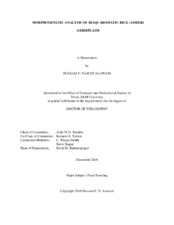| dc.description.abstract | The objective of this work was to determine the agronomic, morphological, and molecular diversity characteristics of Iraq’s aromatic-rice (Oryza sativa L.) cultivars. The first study was conducted for three years (2015, 2016, and 2017) at the Texas A&M AgriLife Research Center in Beaumont. It focused on characterizing and determining the variability of the agronomic and morphological characteristics of Iraq’s aromatic rice cultivars. The cultivars varied significantly for the number of days needed to reach 50% heading, plant height, tillers per square meter, flag-leaf area, panicle lengths, weights of thousand-grain, and percentage of chalky seed.
The second study was conducted at Beaumont and Eagle Lake in 2017 to characterize and determine the variability of agronomic and morphological characteristics of an F2:6 recombinant inbred lines (RIL) population derived from a cross between Amber 33-PI and Antonio rice cultivars. Days to the 50% heading, plant heights, tillers per plant, flag-leaf areas, ligule lengths, panicle lengths, panicles per plant, branches per panicle, the filled grains per panicle, grain yields per plant, chalky seed percentages, number of grains per panicle, sterility percentages, and fertility percentages varied significantly (LSD = 0.05) among locations.
The third study was conducted to study the molecular diversity among 27 aromatic rice cultivars and to map the associated genes of the quantitative trait loci (QTL) in aromatic rice. Data on 21 agronomic and morphological traits were collected from two locations, Beaumont and Eagle Lake, in 2017. All cultivars were genotyped with genotyping-by-sequencing (GBS) to conduct a cluster and principal coordinate analysis (PCoA). Both locations’ data were used for the principal component analyses (PCA) of the phenotypic data of aromatic rice cultivars. Most of the genotypic variance within the data was explained by the first three principal components (PCo1 = 45%, PCo2 = 11%, and PCo3 = 6%). The cultivars were divided into five clusters, which included two clusters of Amber rice cultivars, two clusters of Basmati rice cultivars, and one cluster of the U.S. cultivars. To perform the mapping of the QTL, 120 rice lines were included in this study. Eighteen linkage groups were generated, covering all 12 chromosomes of the rice genome in JoinMap. Twenty-six QTL associated with 21 different traits were identified in the Amber 33-PI X Antonio population. Several of these QTLs for aroma and other morphological and agronomic traits had sufficient variation that can result into the development of single nucleotide polymorphic (SNP) markers for marker-assisted selection and marker-assisted breeding to increasing the efficiency of breeding programs focusing on developing aromatic rice cultivars. | en |


